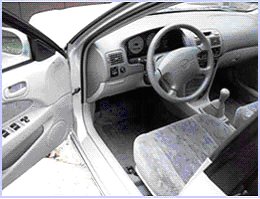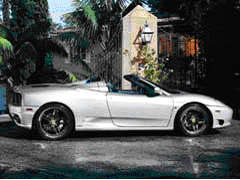Oldsmobile in Popular Culture
The Oldsmobile is notable for having inspired several popular songs:
• "In My Merry Oldsmobile", a 1905 song with music by Gus Edwards and lyrics by Vincent P. Bryan; the song enjoyed a second round of popularity in the 1920s.
• "Rocket 88", a 1951 song by Ike Turner said by many to be the first rock and roll record.
• "You're gonna get yours" from Public Enemy's 1987 debut album Yo! Bum Rush The Show, an ode to the Model 98.
• "455 Rocket", a song cowritten by Gillian Welch, on Kathy Mattea's 1997 album Love Travels.
Oldsmobile 98
From Wikipedia, the free encyclopedia.
The Oldsmobile 98 was a brand name of automobiles made by General
Motors. The name appeared with the first post-World War II
Oldsmobiles in 1946.
It was, as it would remain, the top of the line model, with
lesser Oldsmobiles having lower numbers such as 66 and 76. These
were
replaced by the Oldsmobile
88 in 1949, and the two number-names would carry on into
the 90's as the bread and butter of the full-size Oldsmobile lineup.
Occasionally additional nomenclature was used with the name,
such as L/S and Holiday, and the 98 Regency badge would become
increasingly common
in the later years of the model. The 98 shared its bodyshell
with the Buick Electra.

Phat* rides from 310 Motoring.

Rapper Shows Off His Two Affordable
and Practical Vehicles on "MTV Cribs"
Wiggs weekly 2/14/2004
MTV abruptly halted filming of the latest episode of "Cribs" yesterday,
and plans to scrap the entire segment that featured a tour of platinum-selling
rapper P-Krunk's mansion in suburban Atlanta. Producers said the show was going
well until they were led outside to check out his fleet of presumably tricked-out
rides. "We were shocked, and dare I say appalled, when P-Krunk opened
up his garage door and exposed two non-customized, frequently driven vehicles
showing a bit of wear and tear: a 1998 Ford Aerostar minivan and a 2001 Toyota
Corolla."
Unfazed by the producers' grimaces and gasps of disappointment and confusion, P-Krunk began a detailed tour and description of his average autos.
"Check it dawg, my minivan is mad sensible. It gets crazy gas mileage and it's hella roomy, yo. I'm big pimpin' when I load up my shorties and my crew and we kick it at the Mickey D's drive-thru," said the married, 28-year-old father of two. "Gotsta have the removable back seat too, so me and my boo can be loading up bags of garden mulch and manure at Home Depot."
The rapper carefully wiped down the exterior of his minivan—gently
cleaning some dirt off the "My Child is an Honor Student at Peach
Tree Prep" bumper sticker—with a chamois and moved on to
his "main ride."
The bass was definitely not humping his face as the tinny hip-hop songs barely trickled out of the two, standard three-inch speakers mounted in the grey plastic dashboard.
"You feeling my Corolla?" P-Krunk queried as he relaxed in the cloth-covered driver's seat of the moderately priced, four-door, grey family sedan and played with the small plastic knobs of his factory-installed AM/FM radio with cassette and single CD player. "I like my B.Seigs & Freeway playing at a low, pleasant volume so I can pay attention to the roadeezy fo' sheezy." The bass was definitely not humping his face as the tinny hip-hop songs barely trickled out of the two, standard three-inch speakers mounted in the grey plastic dashboard.
When a cameraman pointed out that the car was missing a hubcap, the rapper laughed and said, "No big thang, nothing a twenty-spot can't fix down at the junk yard."
Asked if he plans on buying more expensive performance cars or a giant Hummer like many of his newly rich contemporaries in the near future, P-Krunk quickly responded, "Ten grand for rims? No my brother, this baller is hanging on to his cheddar. I don't need to be rollin' on dubs to represent and I sho' as shizzle don't plan on being a broke-ass bitch this time next year. Who do I look like, Hammer?"
"Cribs" segment producer Jonah Rothelsberg explained the
reasoning behind shelving the show. "I appreciate P-Krunk's unique
taste, but we have a responsibility to our young viewers and advertisers
to show the real lifestyles that are true to the artist's genre of
music. A rapper who doesn't capriciously spend all his money on cars
and 100-inch plasmas is an anomaly that strains credibility. Our viewers
would think we made this up or were trying to punk them." Rothelsberg
cleared his throat and continued with a grin in a fake urban patois, "Sorry
playa, no hoopties or wankstas allowed on this joint. My homies just
ain't havin' it."
Demian Payton
UsedWigs Trendz Reporter
Wheels
Cruisin' the Strip
Christian Gulliksen
04/27/2003
More than ever, cars have become a fashion statement in the world of entertainers and professional athletes. It was reported recently that invitations to one celebrity-laden bash specified that guests should arrive in black sedans or SUVs— an eyebrow-raising request, to be sure, but indicative that cars have become part of the dress code. Rap and hip-hop artists not only feature cars prominently in their videos— a time-honored practice—but also refer to them by name in their songs. Bentleys and Escalades receive the overwhelming bulk of attention in lyrical wordplay, but the Hummer H2 is catching up. It seems you are what you drive.
If you haven’t thumbed through DUB magazine or watched MTV lately, you might not be aware that the stylistic gulf between a rapper’s car and a CEO’s car is shrinking. In fact, the styles are converging on each other. Musicians, for instance, have enthusiastically embraced Bentleys, traditionally the domain of upper-class conservatism, and country club members have taken to 20-inch wheels on their BMWs with equal fervor. There are, of course, still some superficial differences between the cars they drive. The hip-hop world favors chrome wheels while suburban Connecticut goes for steel. But the difference is slight. Everyone drives the same cars. The Escalade in which a rapper rolls up to a club is not substantially different from the Escalade a mother uses to drop the kids off at soccer practice. Admittedly, the odds of P. Diddy and Donald Trump selecting precisely the same modifications for a car are slim. But don’t be surprised if the choice each makes continues to influence the other.

Myth: There are Welfare Queens driving Welfare Cadillacs.
Fact: Reagan made up this story.
Summary
Reagan's story of a Welfare Queen driving a Welfare Cadillac was apocryphal. Even so, there is no evidence that welfare cheating is a significant problem; besides, individual welfare payments are too small for recipients to live well.
Argument
Conservative politicians have a talent for telling memorable anecdotes that capture the essence of their beliefs on any particular issue. One of the most enduring of these came from Ronald Reagan on the subject of welfare. He cited a Chicago "Welfare Queen" who had ripped off $150,000 from the government, using 80 aliases, 30 addresses, a dozen social security cards, and four fictional dead husbands. The country was outraged; Reagan dutifully promised to roll back welfare; and ever since, the "Welfare Queen" driving her "Welfare Cadillac" has become permanently lodged in American political folklore.
Unfortunately, like most great conservative anecdotes, it wasn't really true. The media searched for this welfare cheat in the hopes of interviewing her, and discovered that she didn't even exist.
As a bit of class warfare, however, it was brilliant. It diverted public attention from insider traders in their limousines to Welfare Queens in their Cadillacs, even though the former were stealing thousands of times more from the American people than the latter. Just one example of the cost of white collar crime would become apparent a few years later, when President Bush bailed out the Savings & Loans industry with $500 billion of the taxpayer's money -- enough to fund 20 years of federal AFDC.
Questions of class warfare aside, there is no evidence that there is a significant problem with welfare cheating. In 1991 less than 5 percent of all welfare benefits went to persons who were not entitled to them, and this figure includes errors committed by the welfare agency. (1)
Nor are people getting rich off welfare. The two largest welfare programs are Aid to Families with Dependent Children (AFDC) and food stamps. In 1992, the average yearly AFDC family payment was $4,572, and food stamps for a family of three averaged $2,469, for a total of $7,041. (2) In that year, the poverty level for a mother with two children was $11,186. (3) Thus, these two programs paid only 63 percent of the poverty level, and 74 percent of a minimum wage job. There are other welfare programs, of course, but they either pay a minuscule fraction of these two programs, or, if larger, are collected by only a small percentage of welfare recipients. The typical welfare recipient remains among the poorest members of society.
Endnotes:
1. Figures provided to the 1994 Green Book, U.S. House Ways and Means Committee, by the Administration for Children and Families, U.S. Department of Health and Human Services.
2. AFDC figures from U.S. Social Security Administration. Food Stamp figures from U.S. Department of Agriculture, "Annual Historical Review of FNS Programs" and unpublished data.
3. U.S. Bureau of the Census, Poverty in the United States, Series P-60, No. 185, 1993.